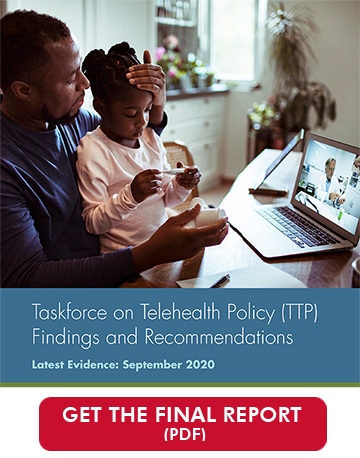 When COVID-19 emerged as a once-in-a-century threat to public health, the use of telehealth became indispensable to maintaining a functioning healthcare system. Federal regulatory and legislative actions, and those taken by private insurers expanded access to telehealth and relaxed regulations to balance health care access with the need to avoid unnecessary physical contact.1 Early data suggest telehealth also relieved travel burdens, reduced missed appointment rates, increased access to behavioral care, reduced skilled nursing facilities transfers to hospitals, boosted transitional care management and enabled patients to choose virtual visits across a much broader range of services. Consensus quickly emerged among many stakeholders, including some members of Congress and the Administration, that many telehealth policy changes should remain in place after the crisis.
When COVID-19 emerged as a once-in-a-century threat to public health, the use of telehealth became indispensable to maintaining a functioning healthcare system. Federal regulatory and legislative actions, and those taken by private insurers expanded access to telehealth and relaxed regulations to balance health care access with the need to avoid unnecessary physical contact.1 Early data suggest telehealth also relieved travel burdens, reduced missed appointment rates, increased access to behavioral care, reduced skilled nursing facilities transfers to hospitals, boosted transitional care management and enabled patients to choose virtual visits across a much broader range of services. Consensus quickly emerged among many stakeholders, including some members of Congress and the Administration, that many telehealth policy changes should remain in place after the crisis.
“Telehealth is a proven and cost-effective way to get care out to patients, particularly during a crisis….We know telehealth can be an essential bridge in delivering care, particularly during a crisis and today we are working to ensure telehealth continues in a post-Coronavirus world.” – Representative Mike Thompson (D-CA)
“It’s taken this crisis to push us to a new frontier, but there’s absolutely no going back,” said Centers for Medicare and Medicaid Services (CMS) Administrator Seema Verma to The Wall Street Journal.2 “I think we need to do everything we can to support the healthcare system, make healthcare more accessible, make it more affordable – and telehealth is one powerful tool that can solve a lot of the problems that we have.”3
“We’re now aggressively looking at how to make the telehealth revolution a permanent part of American medicine,” wrote Health and Human Services (HHS) Secretary Alex Azar. “In many cases, well-meaning anti-fraud and privacy measures make it more difficult than it needs to be. There’s a reluctance to let Medicare pay for more telehealth on the grounds that this will drive up healthcare utilization, straining our healthcare system and the program’s budget. That kind of static thinking is one of the biggest problems in American healthcare. We shouldn’t stand in the way of delivering necessary healthcare services in the most convenient way possible—especially as our healthcare system shifts toward paying for outcomes rather than procedures.”4
Nevertheless, prior concerns about efficacy, appropriateness, fraud, waste and abuse and privacy that fostered previous policy restrictions still linger.
The Taskforce on Telehealth Policy (TTP) was formed to assess the changes occasioned by the pandemic and find agreement on recommendations that would maximize the availability of safe, high-quality and cost-effective telehealth services. Convened by the Alliance for Connected Care, the National Committee for Quality Assurance and the American Telemedicine Association, the TTP represents the perspectives of consumers, physicians, hospitals and health systems, insurers, telehealth platforms, quality measurement experts, and federal government liaisons.5 The TTP divided into subgroups to address specific, often overlapping questions on:6
- Patient Safety and Program Integrity
- Data Flow, Care Coordination and Quality Measurement
- Telehealth Effect on Total Cost of Care.
Finally, this report was aided immensely by input from hundreds of healthcare stakeholders who shared their valuable insights on these and other topics through written comments, virtual meetings and our online Public Comment Town Hall. We hope the findings and recommendations we are sharing help guide policymakers as they chart the future for telehealth.
References
1 Refer to Telehealth Policy Changes Made in Response to COVID-19, page 25.
2 The Doctor Will Zoom You Now, Wall Street Journal, April 26, 2020.
3 The New Normal of Care Delivery, Health IT Leadership Roundtable, July 2020.
4 Trump Administration Aims to Keep Telehealth Revolution Here to Stay, Azar, USA Today, July 31, 2020.
5 Refer to Taskforce on Telehealth Policy Members, page 34.
6 Refer to Taskforce on Telehealth Policy Subgroup and Overarching Questions, page 29.
- Save
Save your favorite pages and receive notifications whenever they’re updated.
You will be prompted to log in to your NCQA account.
Save your favorite pages and receive notifications whenever they’re updated.
You will be prompted to log in to your NCQA account.
- Email
Share this page with a friend or colleague by Email.
We do not share your information with third parties.
Share this page with a friend or colleague by Email.
We do not share your information with third parties.
- Print
Print this page.
Print this page.
